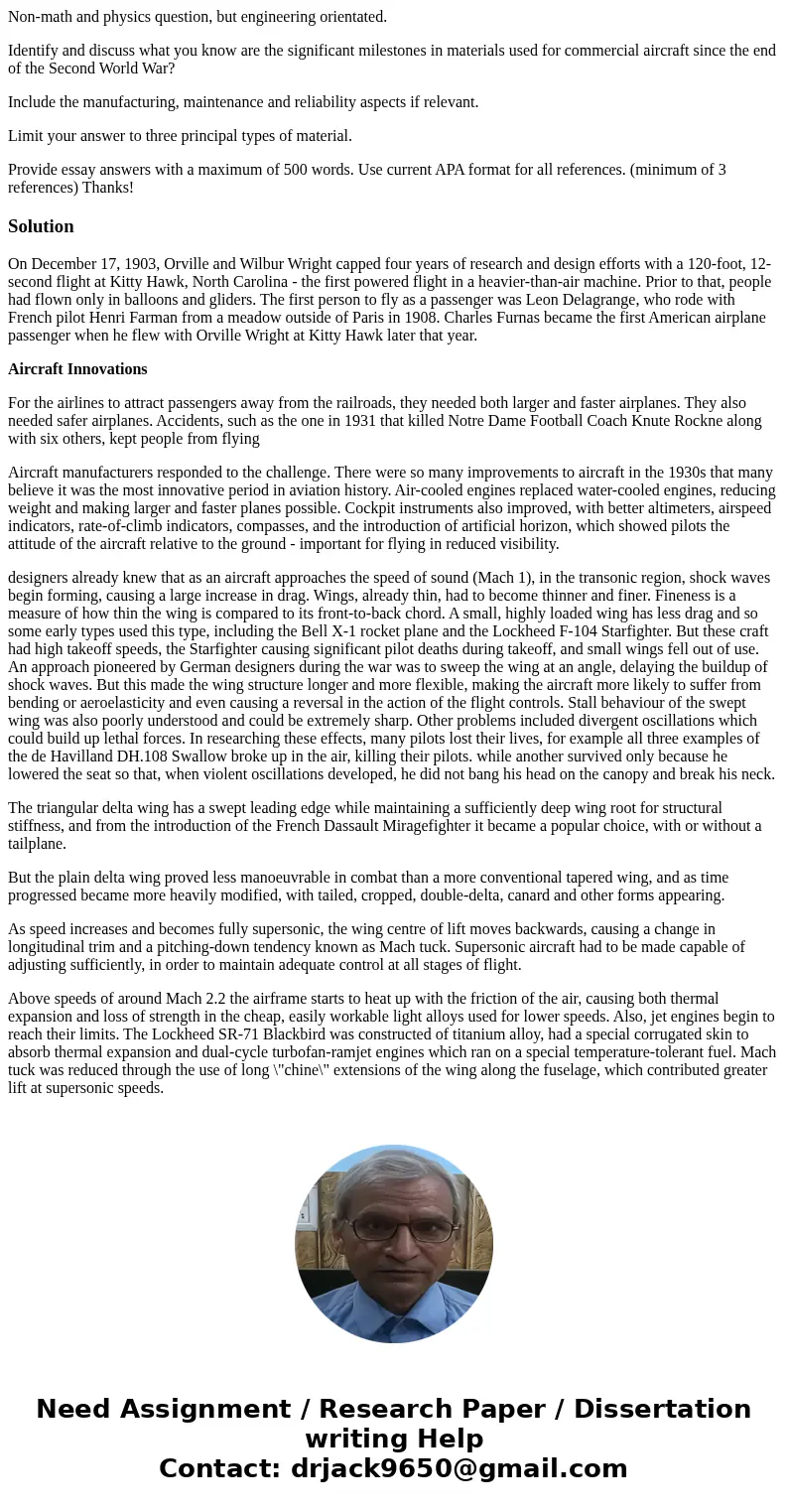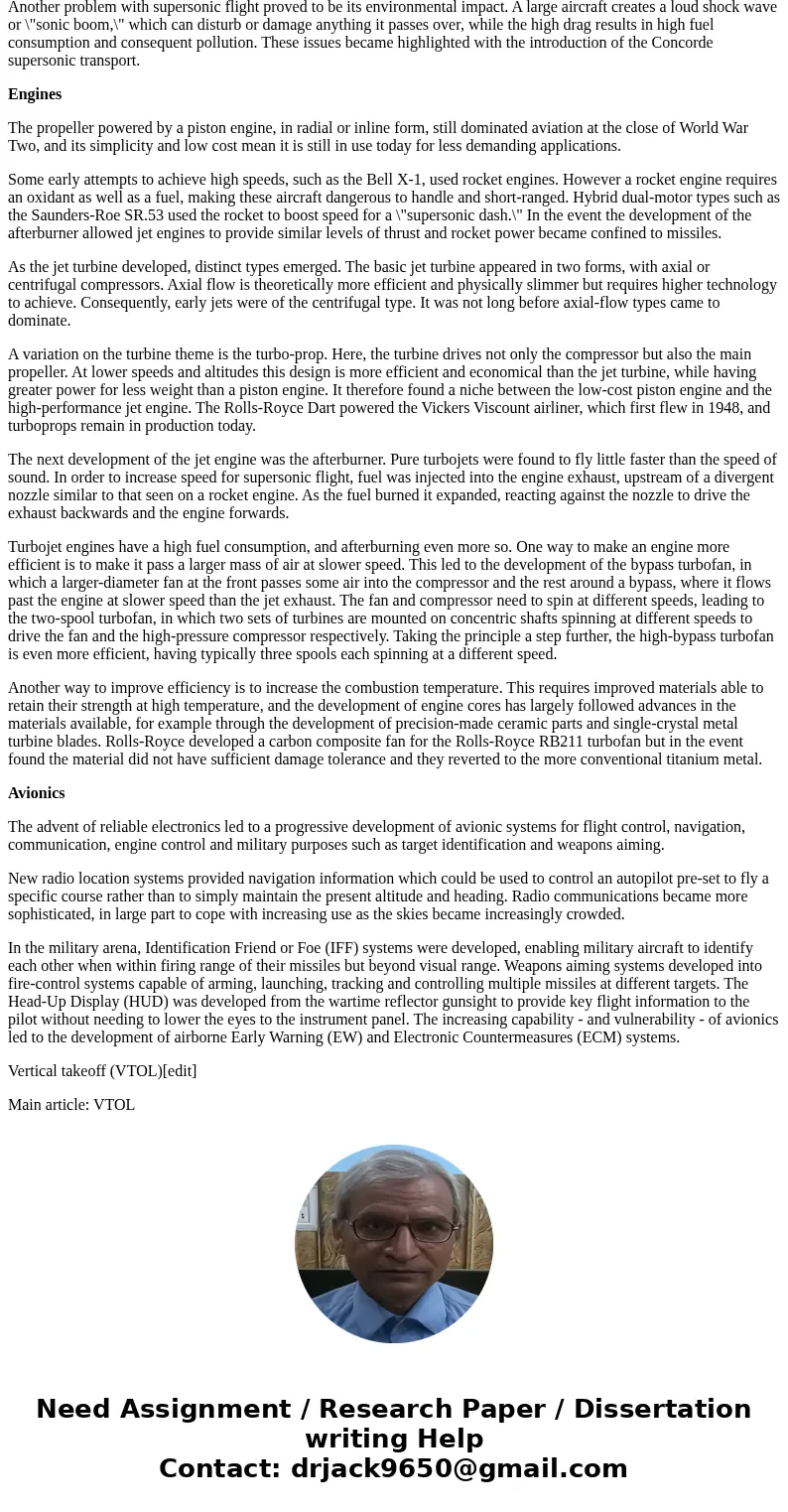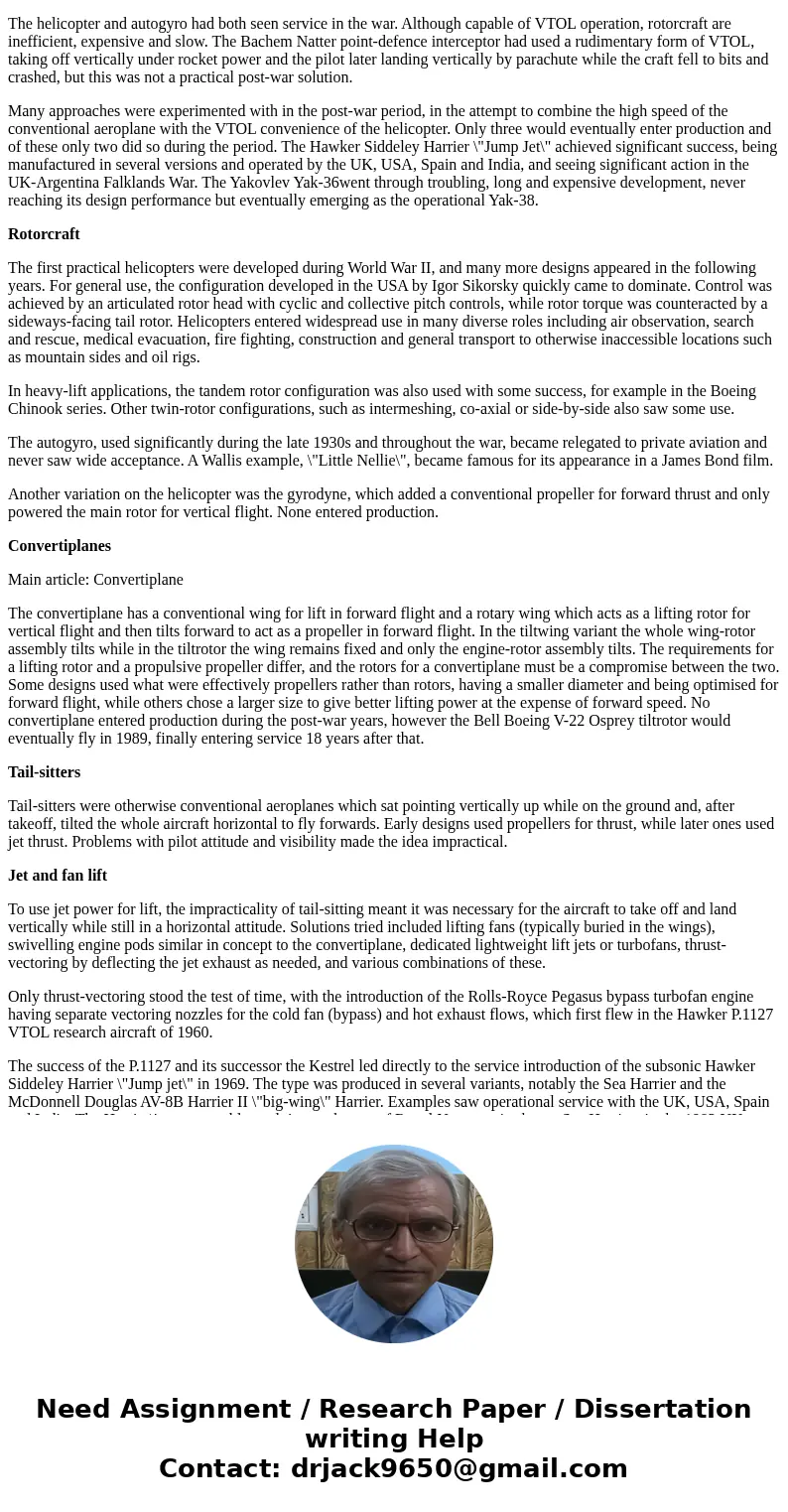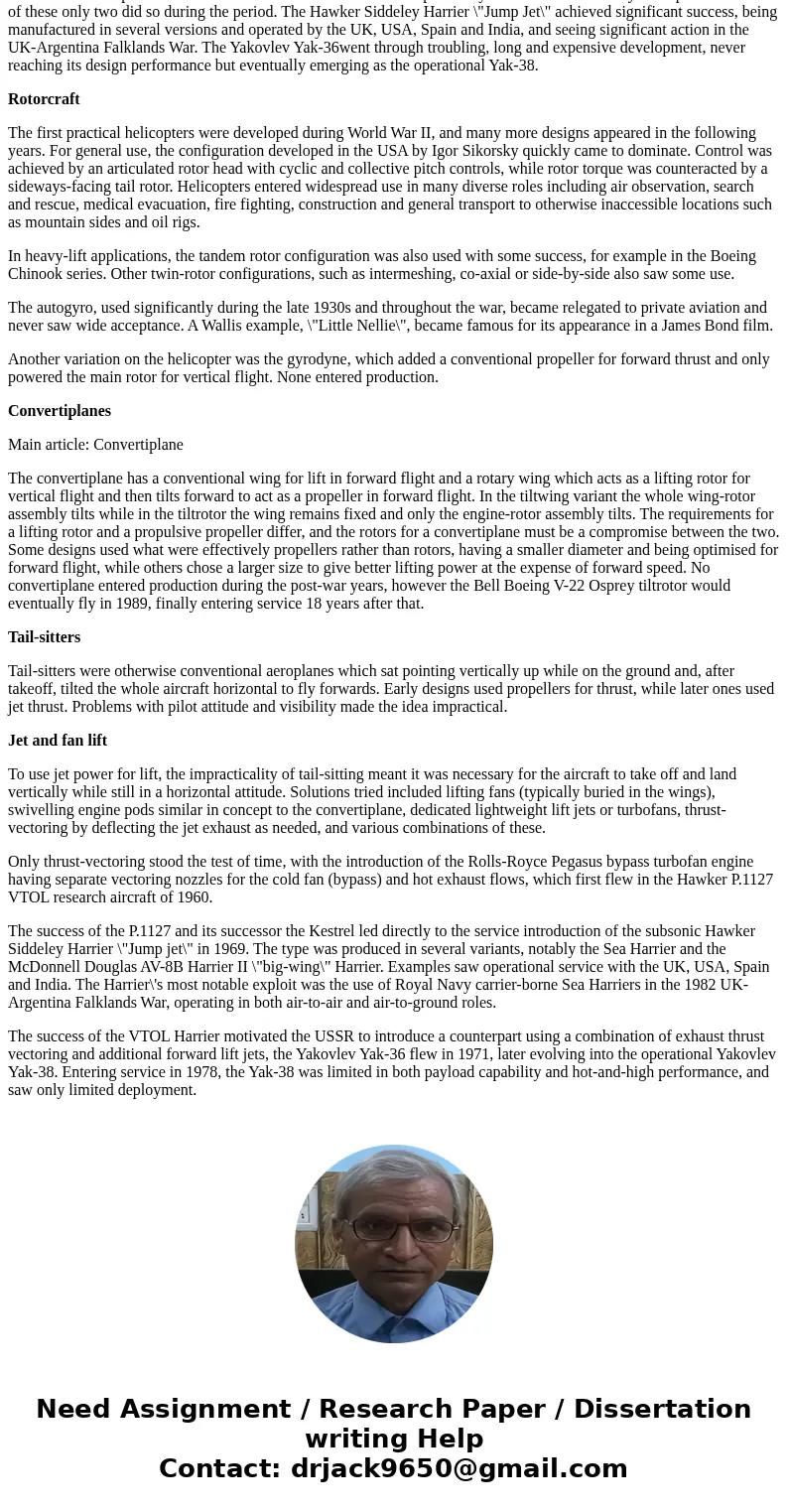Nonmath and physics question but engineering orientated Iden
Non-math and physics question, but engineering orientated.
Identify and discuss what you know are the significant milestones in materials used for commercial aircraft since the end of the Second World War?
Include the manufacturing, maintenance and reliability aspects if relevant.
Limit your answer to three principal types of material.
Provide essay answers with a maximum of 500 words. Use current APA format for all references. (minimum of 3 references) Thanks!
Solution
On December 17, 1903, Orville and Wilbur Wright capped four years of research and design efforts with a 120-foot, 12-second flight at Kitty Hawk, North Carolina - the first powered flight in a heavier-than-air machine. Prior to that, people had flown only in balloons and gliders. The first person to fly as a passenger was Leon Delagrange, who rode with French pilot Henri Farman from a meadow outside of Paris in 1908. Charles Furnas became the first American airplane passenger when he flew with Orville Wright at Kitty Hawk later that year.
Aircraft Innovations
For the airlines to attract passengers away from the railroads, they needed both larger and faster airplanes. They also needed safer airplanes. Accidents, such as the one in 1931 that killed Notre Dame Football Coach Knute Rockne along with six others, kept people from flying
Aircraft manufacturers responded to the challenge. There were so many improvements to aircraft in the 1930s that many believe it was the most innovative period in aviation history. Air-cooled engines replaced water-cooled engines, reducing weight and making larger and faster planes possible. Cockpit instruments also improved, with better altimeters, airspeed indicators, rate-of-climb indicators, compasses, and the introduction of artificial horizon, which showed pilots the attitude of the aircraft relative to the ground - important for flying in reduced visibility.
designers already knew that as an aircraft approaches the speed of sound (Mach 1), in the transonic region, shock waves begin forming, causing a large increase in drag. Wings, already thin, had to become thinner and finer. Fineness is a measure of how thin the wing is compared to its front-to-back chord. A small, highly loaded wing has less drag and so some early types used this type, including the Bell X-1 rocket plane and the Lockheed F-104 Starfighter. But these craft had high takeoff speeds, the Starfighter causing significant pilot deaths during takeoff, and small wings fell out of use. An approach pioneered by German designers during the war was to sweep the wing at an angle, delaying the buildup of shock waves. But this made the wing structure longer and more flexible, making the aircraft more likely to suffer from bending or aeroelasticity and even causing a reversal in the action of the flight controls. Stall behaviour of the swept wing was also poorly understood and could be extremely sharp. Other problems included divergent oscillations which could build up lethal forces. In researching these effects, many pilots lost their lives, for example all three examples of the de Havilland DH.108 Swallow broke up in the air, killing their pilots. while another survived only because he lowered the seat so that, when violent oscillations developed, he did not bang his head on the canopy and break his neck.
The triangular delta wing has a swept leading edge while maintaining a sufficiently deep wing root for structural stiffness, and from the introduction of the French Dassault Miragefighter it became a popular choice, with or without a tailplane.
But the plain delta wing proved less manoeuvrable in combat than a more conventional tapered wing, and as time progressed became more heavily modified, with tailed, cropped, double-delta, canard and other forms appearing.
As speed increases and becomes fully supersonic, the wing centre of lift moves backwards, causing a change in longitudinal trim and a pitching-down tendency known as Mach tuck. Supersonic aircraft had to be made capable of adjusting sufficiently, in order to maintain adequate control at all stages of flight.
Above speeds of around Mach 2.2 the airframe starts to heat up with the friction of the air, causing both thermal expansion and loss of strength in the cheap, easily workable light alloys used for lower speeds. Also, jet engines begin to reach their limits. The Lockheed SR-71 Blackbird was constructed of titanium alloy, had a special corrugated skin to absorb thermal expansion and dual-cycle turbofan-ramjet engines which ran on a special temperature-tolerant fuel. Mach tuck was reduced through the use of long \"chine\" extensions of the wing along the fuselage, which contributed greater lift at supersonic speeds.
Another problem with supersonic flight proved to be its environmental impact. A large aircraft creates a loud shock wave or \"sonic boom,\" which can disturb or damage anything it passes over, while the high drag results in high fuel consumption and consequent pollution. These issues became highlighted with the introduction of the Concorde supersonic transport.
Engines
The propeller powered by a piston engine, in radial or inline form, still dominated aviation at the close of World War Two, and its simplicity and low cost mean it is still in use today for less demanding applications.
Some early attempts to achieve high speeds, such as the Bell X-1, used rocket engines. However a rocket engine requires an oxidant as well as a fuel, making these aircraft dangerous to handle and short-ranged. Hybrid dual-motor types such as the Saunders-Roe SR.53 used the rocket to boost speed for a \"supersonic dash.\" In the event the development of the afterburner allowed jet engines to provide similar levels of thrust and rocket power became confined to missiles.
As the jet turbine developed, distinct types emerged. The basic jet turbine appeared in two forms, with axial or centrifugal compressors. Axial flow is theoretically more efficient and physically slimmer but requires higher technology to achieve. Consequently, early jets were of the centrifugal type. It was not long before axial-flow types came to dominate.
A variation on the turbine theme is the turbo-prop. Here, the turbine drives not only the compressor but also the main propeller. At lower speeds and altitudes this design is more efficient and economical than the jet turbine, while having greater power for less weight than a piston engine. It therefore found a niche between the low-cost piston engine and the high-performance jet engine. The Rolls-Royce Dart powered the Vickers Viscount airliner, which first flew in 1948, and turboprops remain in production today.
The next development of the jet engine was the afterburner. Pure turbojets were found to fly little faster than the speed of sound. In order to increase speed for supersonic flight, fuel was injected into the engine exhaust, upstream of a divergent nozzle similar to that seen on a rocket engine. As the fuel burned it expanded, reacting against the nozzle to drive the exhaust backwards and the engine forwards.
Turbojet engines have a high fuel consumption, and afterburning even more so. One way to make an engine more efficient is to make it pass a larger mass of air at slower speed. This led to the development of the bypass turbofan, in which a larger-diameter fan at the front passes some air into the compressor and the rest around a bypass, where it flows past the engine at slower speed than the jet exhaust. The fan and compressor need to spin at different speeds, leading to the two-spool turbofan, in which two sets of turbines are mounted on concentric shafts spinning at different speeds to drive the fan and the high-pressure compressor respectively. Taking the principle a step further, the high-bypass turbofan is even more efficient, having typically three spools each spinning at a different speed.
Another way to improve efficiency is to increase the combustion temperature. This requires improved materials able to retain their strength at high temperature, and the development of engine cores has largely followed advances in the materials available, for example through the development of precision-made ceramic parts and single-crystal metal turbine blades. Rolls-Royce developed a carbon composite fan for the Rolls-Royce RB211 turbofan but in the event found the material did not have sufficient damage tolerance and they reverted to the more conventional titanium metal.
Avionics
The advent of reliable electronics led to a progressive development of avionic systems for flight control, navigation, communication, engine control and military purposes such as target identification and weapons aiming.
New radio location systems provided navigation information which could be used to control an autopilot pre-set to fly a specific course rather than to simply maintain the present altitude and heading. Radio communications became more sophisticated, in large part to cope with increasing use as the skies became increasingly crowded.
In the military arena, Identification Friend or Foe (IFF) systems were developed, enabling military aircraft to identify each other when within firing range of their missiles but beyond visual range. Weapons aiming systems developed into fire-control systems capable of arming, launching, tracking and controlling multiple missiles at different targets. The Head-Up Display (HUD) was developed from the wartime reflector gunsight to provide key flight information to the pilot without needing to lower the eyes to the instrument panel. The increasing capability - and vulnerability - of avionics led to the development of airborne Early Warning (EW) and Electronic Countermeasures (ECM) systems.
Vertical takeoff (VTOL)[edit]
Main article: VTOL
The helicopter and autogyro had both seen service in the war. Although capable of VTOL operation, rotorcraft are inefficient, expensive and slow. The Bachem Natter point-defence interceptor had used a rudimentary form of VTOL, taking off vertically under rocket power and the pilot later landing vertically by parachute while the craft fell to bits and crashed, but this was not a practical post-war solution.
Many approaches were experimented with in the post-war period, in the attempt to combine the high speed of the conventional aeroplane with the VTOL convenience of the helicopter. Only three would eventually enter production and of these only two did so during the period. The Hawker Siddeley Harrier \"Jump Jet\" achieved significant success, being manufactured in several versions and operated by the UK, USA, Spain and India, and seeing significant action in the UK-Argentina Falklands War. The Yakovlev Yak-36went through troubling, long and expensive development, never reaching its design performance but eventually emerging as the operational Yak-38.
Rotorcraft
The first practical helicopters were developed during World War II, and many more designs appeared in the following years. For general use, the configuration developed in the USA by Igor Sikorsky quickly came to dominate. Control was achieved by an articulated rotor head with cyclic and collective pitch controls, while rotor torque was counteracted by a sideways-facing tail rotor. Helicopters entered widespread use in many diverse roles including air observation, search and rescue, medical evacuation, fire fighting, construction and general transport to otherwise inaccessible locations such as mountain sides and oil rigs.
In heavy-lift applications, the tandem rotor configuration was also used with some success, for example in the Boeing Chinook series. Other twin-rotor configurations, such as intermeshing, co-axial or side-by-side also saw some use.
The autogyro, used significantly during the late 1930s and throughout the war, became relegated to private aviation and never saw wide acceptance. A Wallis example, \"Little Nellie\", became famous for its appearance in a James Bond film.
Another variation on the helicopter was the gyrodyne, which added a conventional propeller for forward thrust and only powered the main rotor for vertical flight. None entered production.
Convertiplanes
Main article: Convertiplane
The convertiplane has a conventional wing for lift in forward flight and a rotary wing which acts as a lifting rotor for vertical flight and then tilts forward to act as a propeller in forward flight. In the tiltwing variant the whole wing-rotor assembly tilts while in the tiltrotor the wing remains fixed and only the engine-rotor assembly tilts. The requirements for a lifting rotor and a propulsive propeller differ, and the rotors for a convertiplane must be a compromise between the two. Some designs used what were effectively propellers rather than rotors, having a smaller diameter and being optimised for forward flight, while others chose a larger size to give better lifting power at the expense of forward speed. No convertiplane entered production during the post-war years, however the Bell Boeing V-22 Osprey tiltrotor would eventually fly in 1989, finally entering service 18 years after that.
Tail-sitters
Tail-sitters were otherwise conventional aeroplanes which sat pointing vertically up while on the ground and, after takeoff, tilted the whole aircraft horizontal to fly forwards. Early designs used propellers for thrust, while later ones used jet thrust. Problems with pilot attitude and visibility made the idea impractical.
Jet and fan lift
To use jet power for lift, the impracticality of tail-sitting meant it was necessary for the aircraft to take off and land vertically while still in a horizontal attitude. Solutions tried included lifting fans (typically buried in the wings), swivelling engine pods similar in concept to the convertiplane, dedicated lightweight lift jets or turbofans, thrust-vectoring by deflecting the jet exhaust as needed, and various combinations of these.
Only thrust-vectoring stood the test of time, with the introduction of the Rolls-Royce Pegasus bypass turbofan engine having separate vectoring nozzles for the cold fan (bypass) and hot exhaust flows, which first flew in the Hawker P.1127 VTOL research aircraft of 1960.
The success of the P.1127 and its successor the Kestrel led directly to the service introduction of the subsonic Hawker Siddeley Harrier \"Jump jet\" in 1969. The type was produced in several variants, notably the Sea Harrier and the McDonnell Douglas AV-8B Harrier II \"big-wing\" Harrier. Examples saw operational service with the UK, USA, Spain and India. The Harrier\'s most notable exploit was the use of Royal Navy carrier-borne Sea Harriers in the 1982 UK-Argentina Falklands War, operating in both air-to-air and air-to-ground roles.
The success of the VTOL Harrier motivated the USSR to introduce a counterpart using a combination of exhaust thrust vectoring and additional forward lift jets, the Yakovlev Yak-36 flew in 1971, later evolving into the operational Yakovlev Yak-38. Entering service in 1978, the Yak-38 was limited in both payload capability and hot-and-high performance, and saw only limited deployment.




 Homework Sourse
Homework Sourse